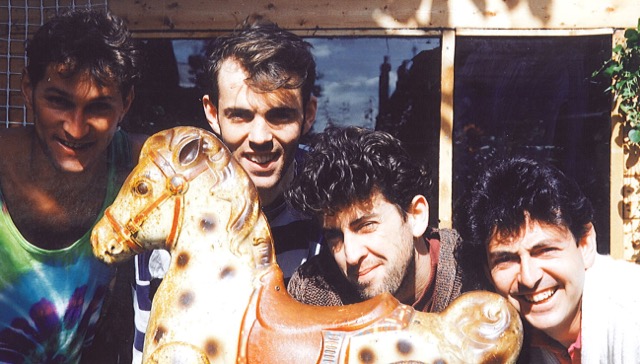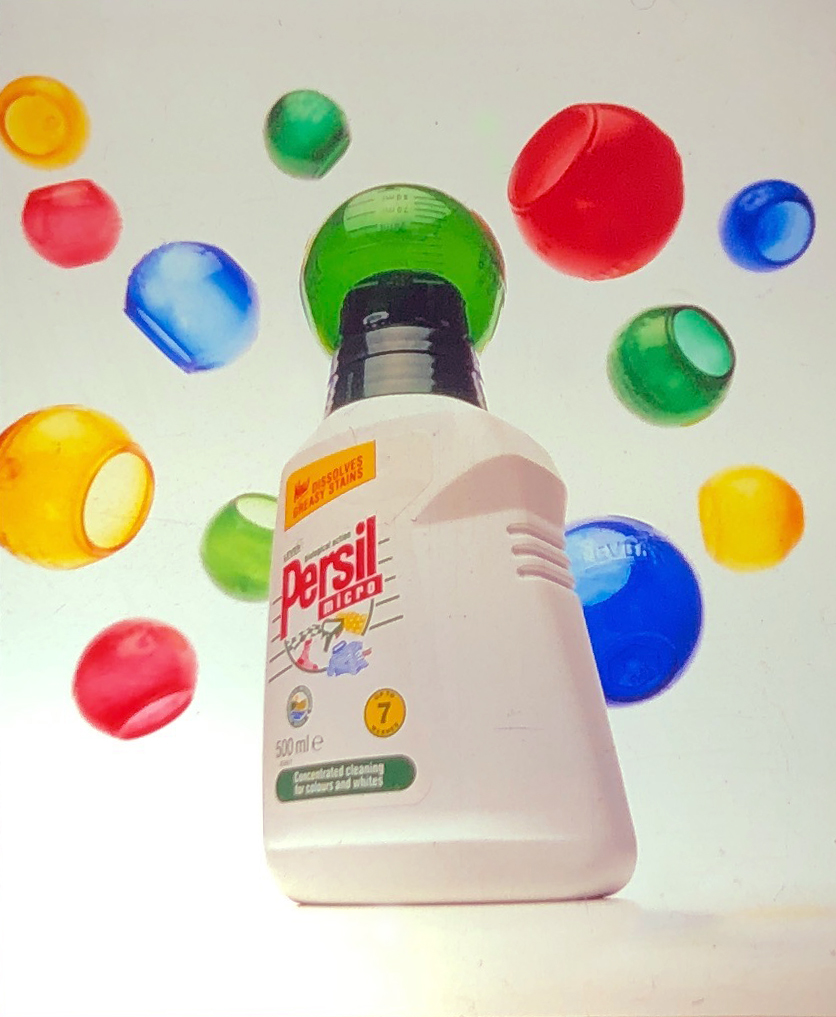
They look like an eighties boy band but these four, fresh-faced scamps were the original award-winning design team behind Tin Horse, widely recognised as one of the first specialists in structural packaging. Together, they created some of the 90’s most iconic pack designs. Here, co-founder David ‘Bic’ Bicknell reflects back to a time when product design was a genuine sculptural art
THIRTY five years ago, I walked into a design studio and was handed my first design challenge. Over the week that followed, I sketched, drew and hand-made prototypes to demonstrate how sweets packaging could transform into kids toys. My efforts prompted the studio to offer me a fulltime job working with its product and graphics team. I was hooked, and I’ve been an avid brand designer ever since.
In my first few years at PI, I was encouraged and inspired to think like a designer – and from the outset I was acutely aware of the value of proving a concept and articulating it to the client. But perhaps more importantly, I saw how crucial prototyping and MVPs (minimum viable products) can be to the momentum and success of good ideas. It was also where I met the three people who became Tin Horse, the first of three companies I’ve founded integrating a two and three-dimensional design approach to solving brand challenges. In those early days we learned that the best way to ensure things work properly, and be viable for manufacture, is to make them yourself. That often meant using whatever methods and materials were at our disposal.
The design industry has moved at an incredible pace since the mid ‘80s, and keeping up to speed with shifts in clients’ expectations is a challenge I’ve always relished. The way we market, consume and attach to products and brands is evolving faster than ever, thanks mostly to ‘digital’. Yet for me, the foundation of a good design approach remains the same: bringing ideas to life at the earliest opportunity, so clients and consumers can experience them… see and feel them… for themselves.
While contemporary digital processes and prototyping techniques are clearly more sophisticated and accurate, one might argue they haven’t bettered product designs proportionally, or helped launch them to market any faster. Often, the simpler, more rudimentary techniques are just as effective, if not more so – especially in providing the physical and tactile context so crucial to real-world application.
What can history tell us?
The 1990s was a golden era for design companies offering genuine innovation. FMCG brand owners were seeking new and exciting ways to package their products, and happily trying ground-breaking designs, without the speed-to-market or sustainability factors they must consider today.
When David Myerson, Martin Bunce, John Lamb and I founded Tin Horse, we were full of naïve enthusiasm for every challenge thrown at us.

Computers and mobile phones were still scientific wizardry. CNC modelling and prototyping was inconceivable. Design concepts were hand-rendered with Nikko Finepoint pens and Magic Markers. And Dick Powell was God.
When I look back over some of the early project designs, they can at first seem simplistic, but they also resonate with imagination, creativity, and optimism. Despite the shortage of obvious ways to make our conceptual drawings real, we believed in them, and we could always find ways to turn them into tactile, real things. Meanwhile, our clients were visionary people who inherently trusted our creativity and ability, and were open to new ways of working.
Creating MVPs without modern modelling techniques
At this point, Tin Horse’s studio was David’s living room in Shepherds Bush, and our ‘breakout spaces’ for brainstorms and meetings were his kitchen or the local pub. Tussie, his long-suffering wife, would put up with foam models, silicone mouldings and epoxy resins constantly encroaching into their living space. David’s garden shed soon became our first model-making workshop. The workbench took up half the floorspace, and we had to cut a hole in the wall to make room for the motor of our 12-inch disc sander. The blade of our small, cheap bandsaw would derail or snap regularly and destroy our precious creations. We used large sheets of blue builders’ insulating foam for carving bottle forms, and we all spent many happy hours huddled together, covered in blue shavings and dust, with little or no regard for goggles, masks, or health and safety in general.
At the time, sustainability was not high on marketers’ agendas, and detergent brands like Persil were more preoccupied with innovative formats that enhanced efficacy and convenience. But at Unilever’s Port Sunlight, Jim Rait and Dave Young had an idea 30 years ahead of its time…
Legend has it that Dave, while in hospital and using his pulp urine bottle, had an epiphany: What if Persil liquid could be packaged in a bottle made from recycled newspapers? Pretty soon, the UK’s largest pulp moulders had provided a comprehensive brief for what was possible, and perhaps more pertinently… what was not. We began creating large pack forms that provided handling, grip and pouring capabilities without a handle, and seeking ways to solve the biggest challenge of all: how to create a closure that was leak-proof and resealable without the threaded screw-top, which wasn’t possible with pulp. If faced with this challenge today, we’d most likely be trying every technique available in CAD modelling, finite element analysis, 3D-printed prototypes and CGI animations. Instead, we carefully hand-drew every presentation, photocopied the line drawings onto layout paper, and then unleashed one of our biggest investments to date… a huge collection of Magic Markers and refill bottles. The pungent smell of markers and lighter fuel would permeate David’s house, while motes of SprayMount and MDF dust sparkled in the sunlight as we conceived and manifested our concepts, and tested our hypotheses. Our biggest handicap was not yet owning a lathe, so we had to fabricate anything cylindrical from things we found in sheds or shops. Countless times we’d set off with a ruler and Vernier callipers to forage the local high street for plumbing fixtures, drainpipes and other plastic products from which to fashion the mechanisms and rigs that would demonstrate our thinking. It was all very rudimentary, but the lack of technology lent a simplicity and urgency that carried the project along at a much faster rate than it would today.
Once a fortnight, team Tin Horse would put on its best shirts and hop on a plane to Liverpool to present ‘Project Relief’s’ latest developments to Jim and his team at Unilever. Gradually we narrowed down the most promising concepts and developed two routes to be prototyped for consumer testing. A complex five-piece, cam-operated closure incorporating a rubber stopper was pilot-tooled for injection moulding, while bottles were mass-produced from tools made directly from the Jelutong wooden masters we’d hand carved and supplied to the pulp moulders. I think we went from concept to in-home consumer testing in less than four months. Despite the available technology, such a timeline would seem far-fetched today.
An endearing strategy
By 1992, Tin Horse had relocated to an empty four-storey warehouse in Shoreditch, long before there was any hint of the trendy, hipster neighbourhood it has since become. We hoisted our huge drawing boards and parallel motion arms up to the top floor and lowered our new milling machines, pillar drills and lathes into the basement. We stripped the walls of old plaster to expose the original brickwork, and installed an eight-foot cable drum as our boardroom table. Our new residence was the antithesis of the Covent Garden designer studios, but the perfect fit for us.
Turning up at meetings with sketches supported by physical models and proof-of-principle rigs was second nature to us. We weren’t particular about materials and techniques, so if something was easier to make with cardboard and plasticine than milled nylon or steel, that was fine with us – and we didn’t care what the client thought because we believed in what it represented. The hot melt-glue gun and 5mm foam board were still staple materials to us, and we had large metal storage units we called ‘the clag drawers’, stuffed with invaluable bits and bobs to make mechanisms and models from. Our experience of getting the best out of rudimentary equipment made us experts at turning our ideas into physical reality very quickly, and this served us well…
This is all a far cry from today’s commercially sensitive climate in which designers promote modern processes and working practices as time-saving, but in many ways they’re simply providing more detail for the same investment. So while they’re undoubtedly ‘adding value’, it doesn’t speed up the overall process. If anything, the early-stage detail is unnecessary, and can slow things down when you hit the ‘how do we make it?’ hurdle.
Our philosophy for all product and structural packaging design processes has been pretty much the same to this day. The way we saw it – and still see it – is that if we could make something function properly and look beautiful in a basic workshop with everyday materials, then it can easily be mass produced and commercially successful.
I still believe that the best results emerge when designers question how they would make it if they were asked to do so. For me, hands-on problem solving is indispensible, but sketching and modelling – the very basics – no longer seem a pre-requisite for careers in product design. There are many (albeit talented) designers who’ve never spent time in a workshop, and instead rely solely on CAD and desktop printers to conceive and produce everything they do.
Packaging innovation
In the ‘90s, marketers embraced not only the idea that structural packaging could be a real product differentiator, but also that it presented an opportunity to improve the user experience and introduce new product formats. For example, the race was on for Unilever brands like Persil and Sure to be first-to-market with concentrated liquids, tablets, two-part formulations and other new formats – and Tin Horse had the skills and approach to meet their demanding briefs.
First out of the blocks was a range of packs for concentrated Persil liquid. To create a family range of bottles was a relatively straightforward task; the real challenge was persuading consumers to bypass the detergent drawer and put it directly into the drum. Procter & Gamble had met a similar problem with their early Ariel liquids, which tended to block the pipes from the drawer to the drum – hence placing balls and other dosing devices into ‘the heart of the wash’ became part of the modern laundry routine. For Unilever, we helped to develop the first urethane balls and made them the heroes of Persil liquid’s brand identity. Our PR image was created long before Photoshop, with all the balls suspended with fishing line. It took an age to stop them spinning and get the winning shot!

Bringing detergent tablets to market proved similarly problematic. Having recovered from the shock of how big they needed to be, we produced multiple hand-carved plaster design samples for evaluation, and prototyped scores of deployment devices. To prevent rapidly dissolving tablets from lodging in garment pockets and sleeves we fabricated and tested endless designs, made from a host of different materials and structures, in a washing machine we bought solely for the purpose.

The point here is that all these projects were with clients who had a far greater capacity for experimentation and trust, and far less fear of failure than many do today. Our first clients at Unilever, Dave Allan and Matt Kingdon, epitomised this philosophy and became good friends of ours. They went on to found What-If and we continued to work with them for many years, solving challenges and bringing products to life in order to test them with consumers and deliver them ‘market-ready’ to brands seeking standout and genuine innovation.
Throughout the ‘90s our team at Tin Horse designed numerous packs for many leading brands, some of which remain in production to this day. Stick and roller-ball deodorants for Rexona and Sure, the first liquid soap packs for Dove and distinctive bottles for packs for Axe, Vosene and Vistra.

1,000,000 years BC (Before Computers)
After three years in Shoreditch we decided to move out of London, and into an old converted dairy farm in Wiltshire… of course! Having a huge open studio and glass-fronted barns meant we could expand, add more workshop machinery and adopt the latest tools of the trade. We left our drawing boards behind and replaced them with desks, and installed a small row of early Macs on a distant table, where we’d run Vellum (Graphite) drawing programmes and occasionally marvel at the newborn ‘internet’. We installed the latest fax machine and even invested in the ‘Omnicrom foil transfer system’ for the graphics team, which today seems quite absurd! Yet we still created presentations by hand with markers, and only the client got the original colour version… everyone else had to make do with grainy black and white photocopies.
During this move, BP had briefed us to redesign their flagship Visco range of bottles as part of their shift towards a greener energy positioning. We threw all our collective talent into this ambitious challenge. Having a global client with numerous stakeholders and regional suppliers meant us finding new ways to communicate our designs. So began our inexorable journey into the digital age! Until this time, we simply sketched bottle designs, and often moved straight into 3D by sticking our sketches onto foam blocks, band-sawing out the elevations, and hand carving the compound surfaces. Now we could create the GA (general arrangement) drawings by hand, or with 2D Vellum software, and generate accurate cross sections with good old foam. As the projects progressed and the designs became more resolved, we’d model in chemical wood, and from here create silicone tooling to produce multiple models for our clients… and to brief the toolmakers. In those days the handover to a toolmaker consisted of an engineering drawing with notes to ‘refer to model’. A good toolmaker would often be producing the graphite spark tool by hand and simply replicating our structural forms. The four litre PB bottle was the last bottle we ever produced that has surfaces created and specified by hand. After that, we’d begun using Alias and Pro-Engineer to build our designs. Nothing was quite the same again…

So was it all better in ‘the good old days’, or has the digital age transformed brand design and innovation services into a more efficient, productive and profitable enterprise?
What we provide clients with, from concept to production, has certainly become way more sophisticated, with far greater detail and precision. Most now expect photo-realistic renders supported by physical samples printed from the same CAD data, whereas not so long ago, they’d gladly decipher the idea from sketches, representative physical models, and explanations from their enthusiastic creators.
Of course, what we can now achieve with modern tools available for prototyping concepts is genuinely amazing and exciting. But often the additional time that design teams invest in creating visual representations and identical 3D models doesn’t reduce project costs or timescales. Instead, it allocates more time and expertise to achieving unnecessary detail in the stages that simply don’t require it. I think advanced processes – as impressive and full of potential as they are – have somewhat de-humanised many of the elements that made product design a genuine sculptural art. As a result, perhaps clients don’t pick up on the equivalent value in today’s conceptual presentations… at least not in the same tangible way.
What we should take from all of this is that, for product and packaging innovation to be a success, it’s far more important to create an MVP using appropriate methods to hand, and to be wary of fixating on the latest technologies. While I’ve always been a strong advocate and eager adopter of anything that helps my design team provide the best service to clients, I’m also a great believer in using a pile of carton board, a hot melt-gun and a scalpel to solve a structural challenge. And I still do.
The best product designers have always been a combination of mad inventor and model-maker, and there will always be a need for people who can cut up a washing- up bottle, stick on a bit of bicycle pump, and invent a new way to atomise hair spray!

David Bicknell
Co-founder of Brown&co, ‘Bic’ founded Tin Horse in 1990. He later co-founded Echo. At Brown&co, he continues to champion an integrated approach to brand-design thinking.



